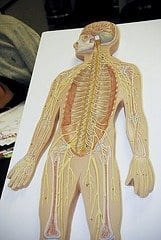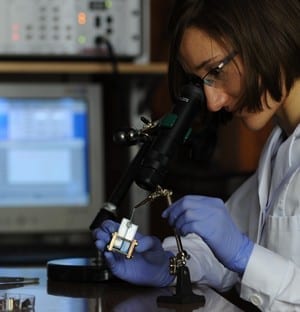
People with spinal cord injuries show strong association of wheelchairs as part of their body, not extension of immobile limbs.
The human brain can learn to treat relevant prosthetics as a substitute for a non-working body part, according to research published March 6 in the open access journal PLOS ONE by Mariella Pazzaglia and colleagues from Sapienza University and IRCCS Fondazione Santa Lucia of Rome in Italy, supported by the International Foundation for Research in Paraplegie.
The researchers found that wheelchair-bound study participants with spinal cord injuries perceived their body’s edges as being plastic and flexible to include the wheelchair, independent of time since their injury or experience with using a wheelchair. Patients with lower spinal cord injuries who retained upper body movement showed a stronger association of the wheelchair with their body than those who had spinal cord impairments in the entire body.
According to the authors, this suggests that rather than being thought of only as an extension of the immobile limbs, the wheelchairs had become tangible, functional substitutes for the affected body part. As Pazzaglia explains, “The corporeal awareness of the tool emerges not merely as an extension of the body but as a substitute for, and part of, the functional self.”
The Latest Bing News on:
Prosthetic devices
- Lauren Lee McCarthy Swaps Stories of Saliva and Surveillanceon May 8, 2024 at 1:23 pm
Bodily Autonomy takes advantage of humor and hyperbole to demonstrate a very real world in which biosurveillance is prevalent overtly and covertly.
- Paul Sugg to speak at LCC’s 62nd Commencement May 9on May 6, 2024 at 11:39 pm
Lenoir Community College will hold its 62nd commencement at 7 p.m. May 9 in the Student Center with Paul Sugg, president of EastPoint Prosthetics & Orthotics, Inc. headquartered in Kinston ...
- ISU graduate’s engineering expertise helps patients recover from brain injurieson May 6, 2024 at 7:32 am
Among the organizations helped by CIRAS is On With Life, an Ankeny-based rehabilitation clinic that helps patients recover from traumatic brain injuries and other neurological conditions. Swacker saw ...
- 'You're not alone in this process': Amputee Brings Awareness to Insurance Coverage on Prostheseson May 6, 2024 at 6:54 am
Nicole Ver Kuilen lost her leg to bone cancer when she was just 10 years old. In the majority of the United States, health insurance providers only cover one "everyday" prosthesis.
- Orthopedic Prosthetics Market Dynamic Resilience Future-Proofing Your Business for Tomorrowon May 5, 2024 at 10:18 pm
Download Free Sample of This Strategic Report with Industry Analysis @ –- Orthopedic Prosthetics Market is valued approximately USD $ million in 2019 and is anticipated to grow with a healthy growth ...
- Archaeologists In Germany Unearthed The Remains Of A Man With A Metal Prosthetic Hand Who Died Sometime Between 1450 And 1620, A Period When Major Medical Advancements Were Madeon May 5, 2024 at 7:26 am
In Freising, Germany, archaeologists unburied the remains of a man with a metal prosthetic hand. The discovery was made ...
- Charity Event to Raise $ for Prosthetic Pediatric Limbson May 1, 2024 at 5:00 pm
A Leg to Stand On—has provided children in emerging countries with the prosthetic limbs and mobility care needed to move independently. Now they are announcing their 4th annual Move for ALTSO event, ...
- Students invent 3D-printed prosthetic arms and explore bee pollination at national STEM competitionon April 30, 2024 at 3:44 pm
There's research on everything from overcoming bias in artificial intelligence to the creation of a $40 3D-printed prosthetic arm. "You can push in a button, lengthen it and it locks back in place," ...
- Artivion presents double win at AATS for aortic deviceson April 30, 2024 at 4:42 am
Artivion has presented positive data from two clinical trials evaluating its On-X aortic valve and AMDS prosthesis device.
- Archaeologists Discover 'Unique' Artificial Body Part in 18th Century Skullon April 29, 2024 at 2:07 pm
The "unusual" object was made with great craftsmanship and would likely have significantly improved the patient's quality of life.
The Latest Google Headlines on:
Prosthetic devices
[google_news title=”” keyword=”prosthetic devices” num_posts=”10″ blurb_length=”0″ show_thumb=”left”] [/vc_column_text]The Latest Bing News on:
Corporeal awareness
- IoT and the Smell of Fire: A Conversation with Dryad Networks for Wildfire Awareness Monthon May 8, 2024 at 8:20 am
We had the opportunity to speak at length with Carsten Brinkschulte, Dryad Networks co-founder and CEO. We discussed IoT sensor technology - powered by advanced ML models - that can 'smell' fires, in ...
- MoH, Zain kick off awareness campaign to promote Child Protection Helpline 147on May 8, 2024 at 7:51 am
KUWAIT: Kuwait Ministry of Health (MoH) in partnership with the country’s leading digital service provider, Zain, announced the kick-off of a nationwide awareness campaign to promote the Child ...
- What are the new social media algorithm rules as Ofcom cracks down on harmful content?on May 8, 2024 at 4:51 am
The 40 suggestions include more robust age verification processes to stop children accessing harmful material, as well as ensuring that ... pressure from parents and campaigners who are raising ...
- National awareness drive on dangers of unstable weatheron May 8, 2024 at 3:28 am
Muscat: The Civil Aviation Authority (CAA), represented by the National Multi-Hazard Early Warning System, the National Center for ...
- MT Attorney General speaks out on National Fentanyl Awareness Dayon May 7, 2024 at 3:55 pm
MONTANA - May 7 is National Fentanyl Awareness Day. According to the CDC, fentanyl overdose is the leading cause of death for Americans between the ages of 18 and 45.
- Longmont promotes International Compost Awareness Week amid calls for more local composting optionson May 6, 2024 at 9:52 am
Organic items currently make up “approximately 30% of the material going to landfills,” according to a proclamation signed by Longmont Mayor Joan Peck, recognizing this week as International Compost ...
- Elida school board debates sexual abuse awareness instructionon May 5, 2024 at 6:24 pm
Elida schools will show sexual abuse prevention videos to students in kindergarten through sixth grade this week, in accordance with a new state law.
- Recent awareness-raising initiatives by States Parties to the 1970 Conventionon May 2, 2024 at 7:07 am
The designations employed and the presentation of the material on this website do not imply the expression ... Alongside UNESCO’s efforts in raising awareness, States Parties to the 1970 Convention ...
- April Marks Fair Housing Awareness Monthon April 29, 2024 at 6:06 am
The month of April marks national Fair Housing Month. It also marks the 56th anniversary of the passage of the Fair Housing Act fighting against housing discrimination. This was a pivotal moment in ...
- GROW: Week in May marks International Compost Awareness Weekon April 27, 2024 at 11:00 am
Bringing awareness to the importance of composting is the goal of International Compost Awareness Week. Slated May 5-11, it is a time to shine a light on why people should ...
The Latest Google Headlines on:
Corporeal awareness
[google_news title=”” keyword=”corporeal awareness” num_posts=”10″ blurb_length=”0″ show_thumb=”left”]









